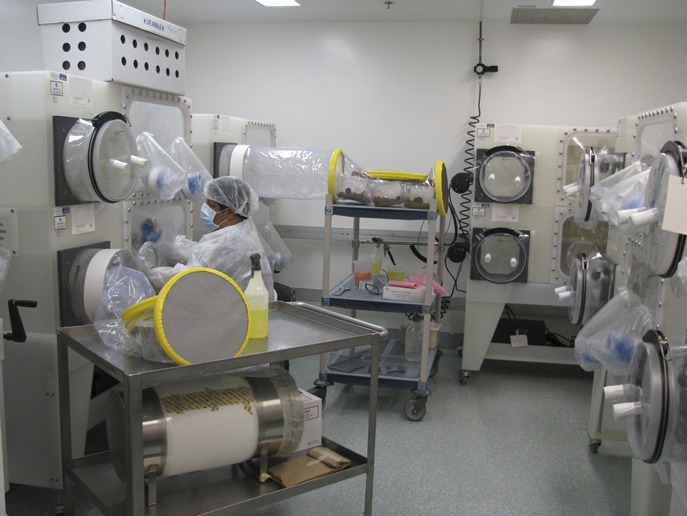The average mouse, like the average human, is home to trillions of bacteria and viruses. The average mouse in a gnotobiotic facility, however, hosts zero. No germs live on its skin, in its nostrils, or in its gut. Its food and water—even its bedding—is heated to more than 100 °C to kill bacteria and viruses before being delivered to its cage through a sterile, fail-safe system of double doors. This is gnotobiotics; the study of organisms whose every germ is carefully controlled.

Germ-free enclosures house mice for gnotobiotic research. Image courtesy of the National Institute of Allergy and Infectious Diseases.
In biology, a common way to study part of a system is to remove it—scientists frequently compare knockout variants to wild-type animals to study the effects of removing specific genes. For scientists studying the effects of bacteria on health and disease, it was a logical step—more than half a century ago—to ask what would happen if an animal lived its life completely unexposed to microorganisms. By 1959, researchers were rearing germ-free mice, rats, guinea pigs, and chicks inside sterile stainless steel and plastic housings (1).
In most ways, today’s methods for keeping gnotobiotic animals have not changed much since the 1950s. To start a germ-free colony, one must remove a young animal from its mother’s womb through a careful surgical procedure to avoid exposing it to the microorganisms in the mother’s vagina and skin. Then, the animal is raised in a sterile cage and only exposed to food, water, and other equipment that has also been sterilized. On a weekly basis—or more often—a technician swabs cages and animal feces to ensure that no bacteria have contaminated the sterile housing. Once the colony has been created, it becomes easier to rear new germ-free animals; a germ-free mother can give birth naturally without exposing her newborns to any bacteria.
Having gnotobiotic animals doesn’t just give researchers the ability to compare germ-free individuals with normally raised ones. Germ-free animals also give a laboratory the ability to introduce one—or a few—microorganisms at a time and look at them in a simpler environment than the bustling metropolis of the microbiome. In the mid-1960s, Russell Schaedler of Rockefeller University began undertaking these experiments, creating different mixtures of bacteria, studying how they each colonized the guts of previously germ-free mice (2), and distributing the so-called “Schaedler Flora” to laboratories around the world.
Today, researchers have realized—in part due to many early studies of gnotobiotic animals—that an organism’s microbiome doesn’t just help it digest food. Mice that are raised germ-free have altered immune systems, hearts, lungs, lymph nodes, metabolisms, and even reproductive abilities. In 2011, a study found that germ-free mice showed altered patterns of brain development and behavior: if the mice were exposed to a mixture of bacteria, the changes reverted back to normal (3). In 2013, a team of researchers discovered that if a sample of the gut microbiota of an obese human were put into a germ-free mouse—with no changes to the mouse’s diet—the mouse would gain weight. If the microbiota sample was instead from a lean human, the weight gain did not occur (4).
As the importance of commensal bacteria and viruses—those that do not harm their host—becomes ever clearer, gnotobiotic animals remain a key tool to studying the interactions between the microbiota and the body. Although humans cannot be raised germ free, samples of human gut microbiomes can be transferred to mice to create human-like gut conditions (5). Researchers now have a plethora of technologies that help them understand the molecular underpinnings of microbiome–physiology links. They can use high-throughput genetic and molecular screening techniques to compare germ-free mice to those with only particular, introduced bacteria in their guts or those with a full menagerie of microbiota (6). Also, mice with any desired genes or gene mutations can be raised germ free to test how a gene may be involved in establishing or controlling the microbiome.
The largest questions in the study of the microbiome—how colonies of microorganisms are established and maintained, how they affect their host, and how the host shapes the populations of germs—all rely on gnotobiotic animals as a tool to advance the field.
References
- 1.Reyniers JA. The pure culture concept and gnotobiotics. Ann NY Acad Sci. 1959;78(1):3–16. [Google Scholar]
- 2.Schaedler RW, Dubos R, Costello R. The development of the bacterial flora in the gastrointestinal tract of mice. J Exp Med. 1965;122(1):59–66. doi: 10.1084/jem.122.1.59. [DOI] [PMC free article] [PubMed] [Google Scholar]
- 3.Diaz Heijtz R, et al. Normal gut microbiota modulates brain development and behavior. Proc Natl Acad Sci USA. 2011;108(7):3047–3052. doi: 10.1073/pnas.1010529108. [DOI] [PMC free article] [PubMed] [Google Scholar]
- 4.Ridaura VK, et al. Gut microbiota from twins discordant for obesity modulate metabolism in mice. Science. 2013;341(6150):1241214. doi: 10.1126/science.1241214. [DOI] [PMC free article] [PubMed] [Google Scholar]
- 5.Goodman AL, et al. Extensive personal human gut microbiota culture collections characterized and manipulated in gnotobiotic mice. Proc Natl Acad Sci USA. 2011;108(15):6252–6257. doi: 10.1073/pnas.1102938108. [DOI] [PMC free article] [PubMed] [Google Scholar]
- 6.Duerkop BA, Clements CV, Rollins D, Rodrigues JL, Hooper LV. A composite bacteriophage alters colonization by an intestinal commensal bacterium. Proc Natl Acad Sci USA. 2012;109(43):17621–17626. doi: 10.1073/pnas.1206136109. [DOI] [PMC free article] [PubMed] [Google Scholar]


